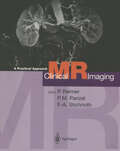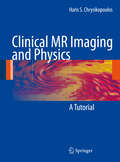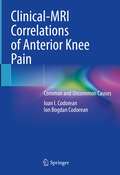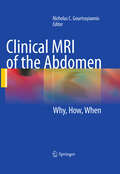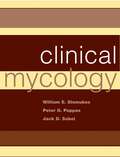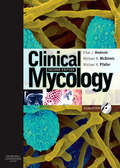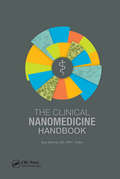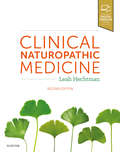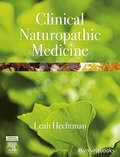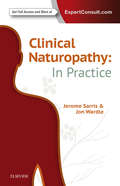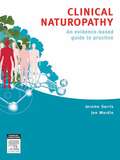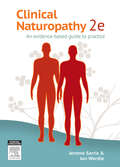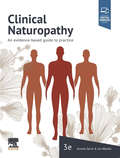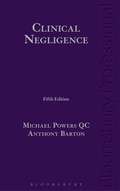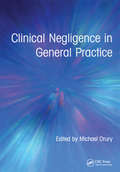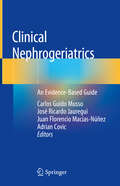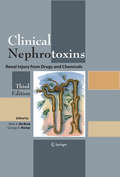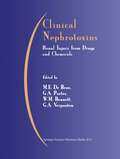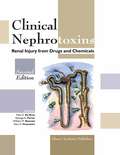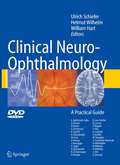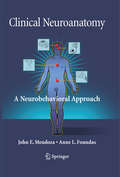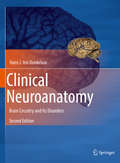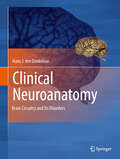- Table View
- List View
Clinical MR Imaging: A Practical Approach
by Falko-A. Stichnoth Paul M. Parizel PeterReimerIn 15 years MRI has evolved into an essential modality, developing from being a preferred neuroimaging method to becoming a whole-body, comprehensive imaging approach. For this, various coils, pulse sequences, and contrast media have been developed. The complexity of the factors to consider often represents an obstacle not only to beginners but also to more experienced technicians and physicians. Since routine diagnostic questions represent more than 90% of clinical examinations, the intention of the editors and authors was to provide an understandable book for this purpose. The book gives practical information about performing effective and efficient MR examinations in daily practice. Solving clinical questions with new sequences should no longer be difficult for beginners in the field.
Clinical MR Imaging and Physics: A Tutorial
by Haris S. ChrysikopoulosKeywords Spin › Electromagnetic radiation › Resonance › Nucleus › Hydrogen › Proton › Certain atomic nuclei possess inherent magnetic Let us summarize the MRI procedure. Te patient properties called spin, and can interact with electro- is placed in a magnetic feld and becomes temporarily 1 magnetic (EM) radiation through a process called magnetized. Resonance is achieved through the - resonance. When such nuclei absorb EM energy they plication of specifc pulses of EM radiation, which is proceed to an excited, unstable confguration. Upon absorbed by the patient. Subsequently, the excess - return to equilibrium, the excess energy is released, ergy is liberated and measured. Te captured signal producing the MR signal. Tese processes are not is processed by a computer and converted to a gray random, but obey predefned rules. scale (MR) image. Te simplest nucleus is that of hydrogen (H), con- Why do we need to place the patient in a m- sisting of only one particle, a proton. Because of its net? Because the earth’s magnetic feld is too weak to abundance in humans and its strong MR signal, H be clinically useful; it varies from 0. 3–0. 7 Gauss (G). is the most useful nucleus for clinical MRI. Tus, foC r urrent clinical MR systems operate at low, mid or our purposes, MRI refers to MRI of hydrogen, and for h igh feld strength ranging from 0. 1 to 3.
Clinical-MRI Correlations of Anterior Knee Pain: Common and Uncommon Causes
by Ioan I. Codorean Ion Bogdan CodoreanThe book addresses comprehensively the normal and pathological MRI appearance of the structures of the anterior compartment of the knee, potential sources of pain, in a systematic way, on anatomical layers, from superficial to deep, respectively, from prepatellar soft tissues to intra-articular structures (the synovial lining, patellar and trochlear cartilage). Anterior knee pain can affect any age group and causes a non-specific clinical picture, making it difficult to establish a precise diagnosis and proper management. MRI is currently the standard gold investigation and findings of common an uncommon causes of anterior knee pain are presented.Written by a radiologist and an orthopaedic surgeon with longstanding experience in MRI of musculoskeletal pathology and in sports traumatology, respectively, the book also presents a unique selection of 80 clinical cases of common and less common pathological conditions of anterior knee pain and subdivided in four groups, according to age, from children and adolescents to older adults.Radiologists and orthopaedic surgeons, as well as sport medicine specialists and physiatrists, will find in this book an invaluable tool for their clinical practice.
Clinical MRI of the Abdomen: Why,How,When
by Nicholas C. GourtsoyiannisThis volume, which explains why, when, and how abdominal MRI should be used, focuses in particular on the most recent developments in the field. After introductory chapters on technical considerations, protocol optimization, and contrast agents, MRI of the various solid and hollow viscera of the abdomen is addressed in a series of detailed chapters. Relevant clinical information is provided, and state of the art protocols presented. With the help of numerous high-quality illustrations, normal, variant, and abnormal imaging findings are described and potential artefacts highlighted. Differential diagnosis is given extensive consideration, and comparisons are made with competing methodologies when relevant. Each of the chapters is rounded off by a section on "pearls and pitfalls". The closing chapters focus on findings in the pediatric abdomen, advances in MRI specifically relevant to cancer patients, and the use of abdominal MRI at 3 Tesla. This book, written by leading experts, will be of value to all who are involved in learning, performing, interpreting, and reporting abdominal MRI examinations.
Clinical Mycology
by William E. Dismukes Peter G. Pappas Jack D. SobelWithin the field of infectious diseases, medical mycology has experienced significant growth over the last decade. Invasive fungal infections have been increasing in many patient populations, including: those with AIDS; transplant recipients; and the elderly. As these populations grow, so does the diversity of fungal pathogens. Paralleling this development, there have been recent launches of several new antifungal drugs and therapies. Clinical Mycology offers a comprehensive review of this discipline. Organized by types of fungi, this volume covers microbiologic, epidemiologic and demographic aspects of fungal infections as well as diagnostic, clinical, therapeutic, and preventive approaches. Special patient populations are also detailed.
Clinical Mycology E-Book
by Elias J. Anaissie Michael R. McGinnis Michael A. PfallerThe first book of its kind to focus on the diagnosis, prevention, and treatment of patients with fungal infections, this definitive reference returns in a completely revised, full-color new edition. It presents specific recommendations for understanding, controlling, and preventing fungal infections based upon underlying principles of epidemiology and infection control policy, pathogenesis, immunology, histopathology, and laboratory diagnosis and antifungal therapy. More than 560 photographs, illustrations, and tables depict conditions as they appear in real life and equip you to identify clinical manifestations with accuracy. Expanded therapy content helps you implement the most appropriate treatment quickly.Includes specific recommendations for diagnosing, preventing, and treating fungal infections in various patient populations based upon underlying principles of epidemiology and infection control policy, pathogenesis, immunology, histopathology, and laboratory diagnosis and antifungal therapy. Covers etiologic agents of disease, fungal infections in special hosts such as pediatric patients and patients with cancer and HIV, infections of specific organ systems, and more, to make you aware of the special considerations involved in certain cases. Features clinically useful and reader-friendly practical tools—including algorithms, slides, graphs, pictorials, photographs, and radiographs—that better illustrate and communicate essential points, promote efficient use in a variety of clinical and academic settings, and facilitate slide making for lectures and presentations. Offers more clinically relevant images—more than 300 in full color for the first time—to facilitate diagnosis. Features expanded therapy-related content, including up-to-date treatment strategies and drug selection and dosing guidelines. Includes several new sections in the chapter on fungal infections in cancer patients that reflect the formidable clinical challenges these infections continue to present. Presents the work of additional international contributors who have defined many of the key issues in the field, providing more of a global perspective on the best diagnostic and management approaches. Uses a new, full-color design to enhance readability and ease of access to information.
The Clinical Nanomedicine Handbook
by Sara BrennerDesigned to foster a stronger awareness and exploration of the subject by practicing clinicians, medical researchers and scientists, The Clinical Nanomedicine Handbook discusses the integration of nanotechnology, biology, and medicine from a clinical point of view. The book highlights relevant research and applications by specialty; it examines nan
Clinical Naturopathic Medicine
by Leah HechtmanWritten by Leah Hechtman, Clinical Naturopathic Medicine is a foundation clinical text integrating the holistic traditional principles of naturopathic philosophy with the scientific rigour of evidence-based medicine (EBM) to support contemporary practices and principles. The text addresses all systems of the body and their related common conditions, with clear, accessible directions outlining how a practitioner can understand health from a naturopathic medicine and apply naturopathic medicines to treat patients individually. These treatments include herbal medicine, nutritional medicine and lifestyle recommendations. All chapters are structured by system and then by condition, so readers are easily able to navigate the content by chapter and heading structure.Systematic text structure to support reader engagementIntegrative naturopathic treatments for all conditions and systemsDetailed and extensively referenced interaction tables for nutritional (supplemental and dietary) and herbal medicines, plus pharmaceutical medicationsSkilfully bridges foundational traditional principles and practice of naturopathy with evidenced-based medicine to assist readers with their integration into the current healthcare systemNew chapters – Diagnostics, Case taking and treatment and Nutritional medicine (Dietary)Rigorously researched with over 10,000 references from the latest scientific papers and historical textsEvery section, chapter, system and condition has been expanded and updated to the latest recommendations
Clinical Naturopathic Medicine - E-Book
by Leah HechtmanClinical Naturopathic Medicine is a foundation clinical text integrating the holistic traditional principles of naturopathic philosophy with the scientific rigour of evidence-based medicine (EBM) to support contemporary practices and principles. The text addresses all systems of the body and their related common conditions, with clear, accessible directions outlining how a practitioner can understand health from a naturopathic perspective and apply naturopathic medicines to treat patients individually. These treatments include herbal medicine, nutritional medicine and lifestyle recommendations. All chapters are structured by system and then by condition, so readers are easily able to navigate the content by chapter and heading structure. The content is designed for naturopathic practitioners and students (both undergraduate and postgraduate levels) and for medical and allied health professionals with an interest in integrative naturopathic medicine. detailed coverage of naturopathic treatments provides readers with a solid understanding of the major therapeutic modalities used within naturopathic medicineeach system is reviewed from both naturopathic and mainstream medical perspectives to correlate the variations and synergies of treatmentonly clinically efficacious and evidence-based treatments have been includedinformation is rigorously researched (over 7500 references) from both traditional texts and recent research papersthe content skilfully bridges traditional practice and EBM to support confident practitioners within the current health care system
Clinical Naturopathy: An Evidence-based Guide To Practice
by Jerome Sarris Jon WardleClinical Naturopathy: In Practice applies the research, principles and treatment protocols outlined in Clinical Naturopathy: An Evidence-Based Guide to Practice, 2nd Edition. Written by a team of world-leading naturopathic practitioners and academics, Clinical Naturopathy: In Practice demonstrates the clinical decision-making processes in treating common conditions. It shares the clinical experiences of the expert authors, provides a gold-standard, integrative approach to real-world cases, and will guide you to deliver better clinical outcomes for your patients.Clinical pearls - key points to take into consideration during the examination processDiagnostic considerationsTreatment protocolsExample prescriptionsExpected outcomes and Signposts for recovery - what to expect if treatment is effective or notFollow-up protocols - a guide of what to expect throughout the patient journey Clinical comprehension questions - to help understand practical concepts that drive the authors' clinical decision making
Clinical Naturopathy: An evidence-based guide to practice
by Jerome Sarris Jon WardleA landmark guide to naturopathic practice in Australia – ideal for naturopaths, naturopathy students and Allied Health and medical practitioners Clinical Naturopathy: An evidence-based guide to practice details key treatment protocols and evidence-based complementary medicine interventions for use in naturopathic practice. This valuable naturopathy resource is authored by leading practitioners in the field. Its unique perspective combines clinical experience with evidence-based substantiation from rigorous medical research. Clinical Naturopathy explores key naturopathic treatments – including herbal treatments, nutritional and dietary treatments and lifestyle treatments – for common medical symptoms and conditions encountered in modern practice. Clinical Naturopathy: An evidence-based guide to practice outlines an introduction to case-taking methodology and naturopathic diagnostic techniques. It then details treatment protocols and naturopathic prescriptions to treat major health conditions within individual body systems. The textbook also offers special sections on naturopathic treatment throughout the life cycle, including paediatrics, pregnancy and aging, as well as complex health conditions like HIV, cancer and pain management. Comprehensive appendices provide additional clinically important material, such as reference levels for laboratory medical tests, nutrient food values and traditional Chinese medical diagnosis. This one-of-a-kind naturopathic reference makes essential reading for practitioners wishing to enhance practical application of their skills in a clinical setting, and advance their knowledge of evidence-based complementary medicine interventions. • addresses pre-clinical and clinical naturopathy subjects (from third year naturopathy to post-graduate level)• focuses on major medical conditions, and outlines naturopathic and integrative medical treatments• features case studies to contextualise theory into relevant clinical application• includes user-friendly clinical decision trees, tables and figures• is rigorously researched with over 4000 references
Clinical Naturopathy: An evidence-based guide to practice
by Jerome Sarris Jon WardleClinical Naturopathy: an evidence-based guide to practice, 2nd edition, E-book by Jerome Sarris and Jon Wardle, articulates evidence-based clinical practice. It details the principles, treatment protocols and interventions at the forefront of naturopathic practice in the 21st century. Clinical Naturopathy: an evidence-based guide to practice 2e E-book, equips you to critically evaluate your patients, analyse treatment protocols, and provide evidence-based prescriptions. This second edition promotes the fundamentals of traditional naturopathy, while pushing the scientific boundaries and driving the steady evolution of the profession of naturopathic medicine. Perfect for: Bachelor of Health Science (Naturopathy) Advanced diploma and Postgraduate students in: • Naturopathy• Western Herbal Medicine• Nutrition• Homoeopathy Complementary health therapists General Practitioners Nursing students Pharmacy students Benefits: • Provides an evidence-based, referenced analysis of the treatment protocols underpinning the therapeutic use of CAM interventions.• Emphasizes the treatment of patients not diseases within the systems based structure. • A rigorously researched update of common clinical conditions and their naturopathic treatment according to evidence-based guidelines (over 5,000 references).• Bridges conventional medical and naturopathic paradigms to help clinicians facilitate truly integrative models of care.• Augmented appendices including: herb/drug interaction charts, laboratory reference values, food sources of nutrients, cancer medication interactions and nutraceutical use.• Key Treatment Protocols throughout the text offer an evidence-based referenced critique.• Naturopathic Treatment trees for each condition, with Treatment Aims boxes that are easy to follow and understand.• Scientific and traditional evidence validating treatment protocols.• Decision trees, unique figures, tables and charts are a great aid to visual learners. • Expanded Diagnostics chapter including the emerging field of pharmacogenomics.• New Wellness, lifestyle and preventive medicine chapter to explore in detail the core principles of naturopathic practice.• New Liver dysfunction and disease, Headache and migraine, and Pain chapters.• A deepening scientific focus with inclusion of new and emerging naturopathic therapeutics such as injectable nutraceuticals.
Clinical Naturopathy: An evidence-based guide to practice
by Jerome Sarris Jon WardleWritten by Jerome Sarris and Jon Wardle, Clinical Naturopathy: An evidence-based guide to practice articulates evidence-based clinical practice. It details the principles, treatment protocols and interventions at the forefront of naturopathic practice in the 21st century. Clinical Naturopathy equips you to critically evaluate your patients, analyse treatment protocols, and provide evidence-based prescriptions. A rigorously researched update of common clinical conditions and their naturopathic treatment according to evidence-based guidelinesTreatment decision treesOutline of core principles of naturopathic practice Herb–drug interactions tableLaboratory reference valuesFood sources of nutrientsCancer medication interactionsIncludes an Enhanced eBook version with purchase. The enhanced eBook allows the end user to access all of the text, figures, and references from the book on a variety of devices.
Clinical Negligence
by Michael Powers QC Anthony BartonClinical Negligence, Fifth Edition remains the only text of its kind to cover both medical and legal aspects of medical negligence. Written by a team of 54 experts, it continues to provide the most comprehensive and authoritative guidance on all aspects of clinical negligence claims from bringing an action for damages to presenting expert evidence in court. It also includes detailed consideration of funding and cost implications.Those needing clear updated guidance to make the best possible preparations for an action will find all they need here.Updates in the fifth editionSome of the key developments covered in the new edition are:New funding regime under Legal Aid, Punishment and Sentencing of Offenders Act 2012Montgomery v LanarkshireThe Mid Staffordshire NHS Foundation Trust Public Inquiry (“Francis Report”)Sienkievicz v Greif Bailey v Ministry of Defence on causationWhetstone v MPS and Woodland v Essex County Council on liability of practicesPrivatisation of funding access to justice in clinical negligenceNew costs regime (QOWCS) under Civil Procedures RulesCoroners and Justice Act 2009 and secondary legislationEasy-to-access structureThe new edition maintains its easy-to-access, two-part structure. The first part, set out in 17 chapters, deals with legal aspects of medical malpractice, including complaints procedures, poor performance and medical professional governance, preparation of medical evidence, settlements and trial. The final 25 chapters in the second part cover the risks associated with particular areas of specialist medical practice. Previous print edition ISBN: 9781847660756
Clinical Negligence in General Practice
by Michael DruryThis, the second edition of a text which aims to assist in the identification of skin lesions, contains extra text, algorithms and colour illustrations. Topics overed include erythematous and non-erythematous rashes and lesions on the face, trunk and limbs.
Clinical Negligence in General Practice
by Michael DruryThis, the second edition of a text which aims to assist in the identification of skin lesions, contains extra text, algorithms and colour illustrations. Topics overed include erythematous and non-erythematous rashes and lesions on the face, trunk and limbs.
Clinical Nephrogeriatrics: An Evidence-Based Guide
by Carlos Guido Musso José Ricardo Jauregui Juan Florencio Macías-Núñez Adrian CovicThe increase in average life expectancy observed over recent decades has brought new challenges to nephrology practice. Several renal diseases are more frequent in elderly patients today, and even in healthy older individuals renal physiology has its own peculiarities. This leads to the need for a specific approach on renal aging and renal function in the elderly. However, despite the relevance of this topic, there are few books exclusively dedicated to geriatric nephrology. This book fills this gap by presenting a comprehensive overview of the differences between normal renal aging and chronic renal disease in the aged, and describes the particular aspects of nephropathy in the elderly, addressing it in a practical and clinically applicable fashion. Clinical Nephrogeriatrics bridges the gap between nephrology and geriatrics, discussing the most important issues concerning the relationship between these two medical specialties. This evidence-based resource, written by prominent specialists with extensive clinical experience, offers nephrologists, geriatricians, family physicians, and other medical professionals valuable practical guidelines and insights to enhance their clinical practice and provide optimal care.
Clinical Nephrotoxins: Renal Injury from Drugs and Chemicals
by William M. Bennett Gilbert DerayClinical Nephrotoxins: Renal Injury from Drugs and Chemicals, Third Edition is a comprehensive text on all aspects of adverse effects by drugs, chemical substances and radiation on the kidneys. The importance of the toxicity of drugs and other substances for the kidneys is increasingly recognized. The book consists of themes such as clinical relevance, renal handling and cellular mechanisms of nephrotoxicity, as well as animal and cell culture models. In addition, the volume highlights specific types of drugs, such as anti-infectious agents and anti-inflammatory, cardiovascular and anti-cancer drugs. The last section deals with prevention and focuses on urinary biomarkers, pharmacological aspects and drug dosage in renal failure. In this third and completely revised edition, several new topics were added and additional figures and tables will be included. The book is of interest for the nephrologist, internist, general practitioner, toxicologist, pharmacologist, anesthesiologist, epidemiologist, public health official, pharmaceutical industry, and national drug safety committees, among others.
Clinical Nephrotoxins: Renal Injury from Drugs and Chemicals
by Marc E. De Broe George A. Porter William M. Bennett G. A. VerpootenGEORGE A. PORTER information is an international commodity whose The field of clinical nephrotoxicity involves toxins of interpretation and application are strongly influenced diverse origin and exposure. A significant contribution by both the cultural and ethnic background of the to this problem arises from registered and non-regis observer. The opportunity to share in the rich diversity tered drugs either prescribed or purchased over the of the international scientific community was a fun counter. Another major contributor comes from occu pational or industrial exposures. Each situation pre damental goal of this endeavor. To participate as sents the nephrologist with unique challenges con equals leads to mutual respect and peer appreciation. cerning diagnosis, confirrnation, and treatment includ The sharing of intellectual resources which such an ing limitation from future exposure. In selecting drugs effort fosters, should facilitate the advancement of for inclusions in this book the editors were guided by sound science. both frequency and current knowledge. For occupa Our approach to the field of nephrotoxicity is from tionall environmental exposures similar guidelines the perspective of a book which will be of value to the were applied. As one reviews the world's literature clinician. In this respect we have chosen compounds concerning nephrotoxicity two types of investigation wh ich are of current importance to the nephrologist and his/her patient rather than of historical interest.
Clinical Nephrotoxins: Renal Injury from Drugs and Chemicals
by Marc E. de Broe George A. Porter William M. Bennett Gert A. VerpootenTo you the reader, the joy of discovery begins, for We continue in our goal of providing a text which us the job is done. In this edition, we have corrected is useful, not only to the clinician, but of equal interest past deficiencies, added new topics, expanded infor- to the investigator. The selection of content has been mation regarding the pediatric age group, provided directed at topics of current interest rather than those up to date (March 2003) references, while remaining of historic contribution. We have stressed the cont- true to our concept of a multi-national author book. bution of cell biology and pathophysiology, were it We continue to believe that scientific information is an exists, believing it provides both a better understa- international commodity whose interpretation and ap- ing of toxic injury when known, and a rational dir- plication are strongly influenced by both the cultural tion for therapy and prevention. and ethnic background of the observer. The oppor- nity to share in the rich diversity of the international We are encouraged by the accumulation of rec- scientific community remains a fundamental goal of nized risk factors, which allow pre-treatment strati- this endeavor. To participate as equals leads to mu- cation of our patients’ relative risk and allow us to - tual respect and peer appreciation. The sharing of in- cus our preventative techniques on the individuals tellectual resources fostered by this effort should and most likely to gain the greatest benefit.
Clinical Neuro-Ophthalmology: A Practical Guide
by Helmut Wilhelm William Hart Ulrich Schiefer W. Hart W. F. HoytThis book covers all relevant techniques of diagnosis as well as interpretations of clinical signs in Clinical Neuro-Ophthalmology. All information is highly structured, highlighting ‘definition’, ‘note’ and ‘pearl’, so that it can also be used by the physician during the patient encounter. The included flow chart posters remind the physician of the most important information. This unique and practical guide offers invaluable and practical advice for physicians treating patients with neuro-ophthalmic problems.
Clinical Neuroanatomy: A Neurobehavioral Approach
by John Mendoza Anne FoundasClinical Neuroanatomy offers an extensive review of higher cortical – behavioral functions and their anatomical substrates. The book begins with a review of the basic internal and external morphology, major nerve and fiber tracts, behavioral correlates, and clinical syndromes associated with spinal cord, brain stem, and cerebellum, reacquainting readers with the functional anatomy of the subtentorial central nervous system. The central chapters offer more detailed, integrated, and, at times, theoretical models of cortical systems and their internal organization. Additional chapters highlight vascular anatomy and neurochemical systems. Nearly 300 illustrations help identify key structures and pathways, as well as providing clinical and pathological examples.
Clinical Neuroanatomy: Brain Circuitry and Its Disorders
by Hans J. ten DonkelaarConnections define the functions of neurons: information flows along connections, as well as growth factors and viruses, and even neuronal death can progress through connections. Accordingly, knowing how the various parts of the brain are interconnected to form functional systems is a prerequisite for properly understanding data from all fields in the neurosciences. Clinical Neuroanatomy: Brain Circuitry and Its Disorders bridges the gap between neuroanatomy and clinical neurology. It focuses on human and primate data in the context of brain circuitry disorders, which are so common in neurological practice. In addition, numerous clinical cases are presented to demonstrate how normal brain circuitry can be interrupted, and what the effects are. Following an introduction to the organization and vascularization of the human brain and the techniques used to study brain circuitry, the main neurofunctional systems are discussed, including the somatosensory, auditory, visual, motor, autonomic and limbic systems, the cerebral cortex and complex cerebral functions. In this 2nd edition, apart from a general updating, many new illustrations have been added and more emphasis is placed on modern techniques such as diffusion magnetic resonance imaging (dMRI) and network analysis. Moreover, a developmental ontology based on the prosomeric model is applied, resulting in a more modern subdivision of the brain. The new edition of Clinical Neuroanatomy is primarily intended for neurologists, neuroradiologists and neuropathologists, as well as residents in these fields, but will also appeal to (neuro)anatomists and all those whose work involves human brain mapping.
Clinical Neuroanatomy: Brain Circuitry and Its Disorders
by Hans J. ten DonkelaarConnections define the functions of neurons: information flows along connections, as well as growth factors and viruses, and even neuronal death may progress through connections. Knowledge of how the various parts of the brain are interconnected to form functional systems is a prerequisite for the proper understanding of data from all fields in the neurosciences.Clinical Neuroanatomy: Brain Circuitry and Its Disorders bridges the gap between neuroanatomy and clinical neurology. It emphasizes human and primate data in the context of disorders of brain circuitry which are so common in neurological practice. In addition, numerous clinical cases demonstrate how normal brain circuitry may be interrupted and to what effect. Following an introduction into the organization and vascularisation of the human brain and the techniques to study brain circuitry, the main neurofunctional systems are discussed, including the somatosensory, auditory, visual, motor, autonomic and limbic systems, the cerebral cortex and complex cerebral functions.
